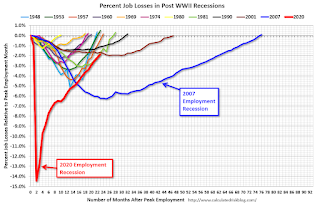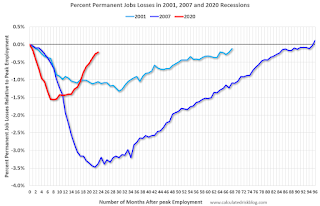by Calculated Risk on 3/03/2022 11:25:00 AM
Thursday, March 03, 2022
February Employment Preview
On Friday at 8:30 AM ET, the BLS will release the employment report for February. The consensus is for 400,000 jobs added, and for the unemployment rate to decrease to 3.9%.
 Click on graph for larger image.
Click on graph for larger image.• First, currently there are still about 2.9 million fewer jobs than in February 2020 (before the pandemic).
This graph shows the job losses from the start of the employment recession, in percentage terms.
The current employment recession was by far the worst recession since WWII in percentage terms. However, the current employment recession, 23 months after the onset, is now significantly better than the worst of the "Great Recession".
• ADP Report: The ADP employment report showed a gain of 475,000 private sector jobs, well above the consensus estimates of 320,000 jobs added. The ADP report hasn't been very useful in predicting the BLS report, but this suggests the BLS report could be above expectations.
• ISM Surveys: Note that the ISM services are diffusion indexes based on the number of firms hiring (not the number of hires). The ISM® manufacturing employment index decreased in February to 52.9%, down from 54.5% last month. This would suggest no change in manufacturing employment in February. ADP showed 30,000 manufacturing jobs gained.
The ISM® Services employment index decreased in February to 48.5%, down from 52.3% last month. This would suggest a 30 thousand increase in service employment in February. Combined, the ISM indexes suggest employment well below the consensus estimate.
• Unemployment Claims: The weekly claims report showed a decrease in the number of initial unemployment claims during the reference week (includes the 12th of the month) from 290,000 in January to 249,000 in February. This would usually suggest fewer layoffs in February than in January, although this might not be very useful right now. In general, weekly claims were close to expectations in February.
 • Permanent Job Losers: Something to watch in the employment report will be "Permanent job losers". This graph shows permanent job losers as a percent of the pre-recession peak in employment through the January report.
• Permanent Job Losers: Something to watch in the employment report will be "Permanent job losers". This graph shows permanent job losers as a percent of the pre-recession peak in employment through the January report.This data is only available back to 1994, so there is only data for three recessions. In January, he number of permanent job losers decreased to 1.630 million from 1.703 million the previous month.
These jobs will likely be the hardest to recover, so it is a positive that the number of permanent job losers is declining fairly rapidly.
• COVID: As far as the pandemic, the number of daily cases during the reference week in February was around 200,000, down sharply from around 800,000 in January. The current wave peaked during the January reference week, and declined in February
• Conclusion: There is optimism concerning the February employment report due to the sharp decline in COVID cases. Overall, the ADP report was solid, and unemployment claims decreased during the reference week. However, the ISM employment surveys were weak in February. My sense is the report will be below consensus expectations.


